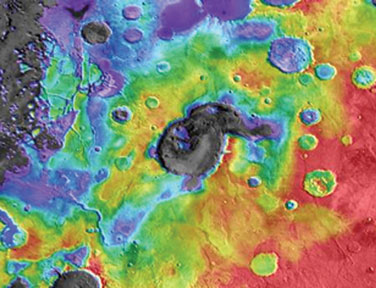Giant Super-volcanoes found on Mars
Titanic eruptions may have played critical role in formation of
planet's early atmosphere millions of years ago
Giant "supervolcanoes" that could eject 1,000 cubic kilometres of
material in one massive eruption - about 200 times the size of the Mount
Pinatubo eruption in the Philippines in 1991 - has been discovered on
Mars.
 Scientists said that the supervolcanoes, which are now extinct, may
have played a critical role in the formation of the planet's early
atmosphere many millions of years ago when the planet could have
supported microbial life-forms. Scientists said that the supervolcanoes, which are now extinct, may
have played a critical role in the formation of the planet's early
atmosphere many millions of years ago when the planet could have
supported microbial life-forms.
Features typical of supervolcanoes, which erupt suddenly with immense
energy and do not leave cone-shaped mountains behind like the more
slowly erupting volcanoes on Earth, have been discovered in an area of
Mars not previously thought to be volcanic, said Joseph Michalksi of the
Natural History Museum in London and the Planetary Institute in Tucson,
Arizona.
"The atmosphere of any planet including our own comes largely from
volcanic outgassing. If we want to know about the early phase of that we
need to know about these early volcanoes and this discovery gives us an
early window into that process," Dr Michalski said.
One of the examples of a Martian supervolcano is the Eden Patera, an
irregularly-shaped crater in an area of Mars called the Arabia Terra.
Discovering such supervolcanic structures "fundamentally changes how
we view ancient volcanism on Mars", said Dr Michalksi, who led the study
published in Nature .
"Many Martian volcanoes are easily recognised from their massive
shield-shaped structure, similar to what we see in Hawaii. But, these
are relatively youthful features on Mars and we have always wondered
where the ancient volcanoes are. It is possible that the most ancient
volcanoes were much more explosive and formed structures similar to what
we now see in Arabia Terra," Dr Michalksi said.
"It makes sense that supervolcanoes might have been more common on
ancient Mars, particularly if the ancient crust was thinner than it is
now. This would allow magma to rise to the surface more quickly, before
it could release gases within the crust," he said. "If future work shows
that supervolcanoes were present more widely on ancient Mars, it would
completely change estimates of how the atmosphere formed from volcanic
gases, how sediments formed from volcanic ash and how habitable the
surface might have been.
"Volcanism is the thread binding nearly every aspect of Mars'
geologic evolution. The better we understand volcanism on Mars, the
better we can understand the planet as a complex system," he said.
Supervolcanoes also exist on Earth, such as at Yellowstone National
Park in Wyoming and Toba in Indonesia, which erupted about 73,000 years
ago and caused a period of extensive global cooling for many years.
-The Independent
|

